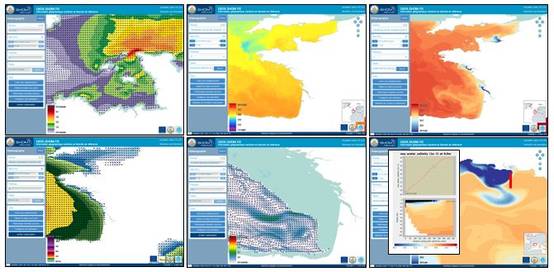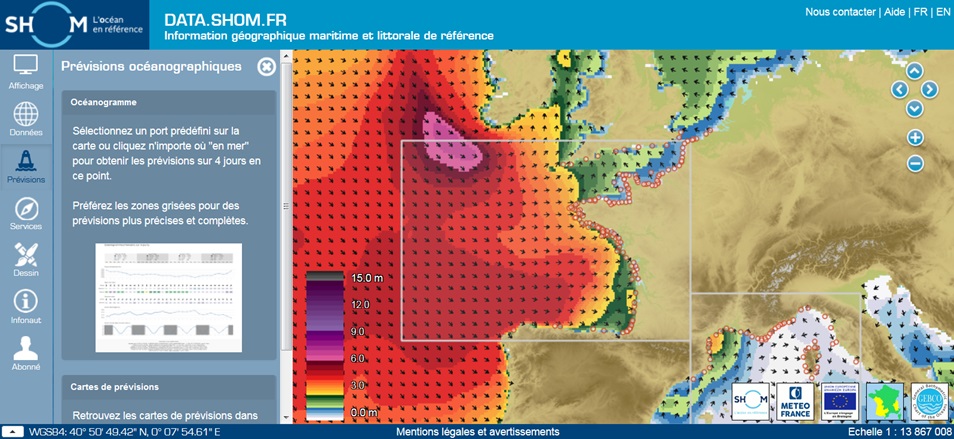Data.shom.fr oceanographic coastal forecasts
Mis à jour le 02/10/2020
The Shom coastal oceanographic forecasts data.shom.fr
Data.shom.fr offers an innovative online platform for the visualisation, exploitation and analyse of the Shom & Météo-France coastal forecasts.
Shom wants to settle a modern national coastal forecast service with dedicated services in order to meet the specific needs of the public marine policies, and also of every single user of the sea (either public or private).
The main objective is to deliver a free and user-friendly service with high resolution coastal forecasts in order to stimulate the private sector that may use them for added-value products, and to encourage the blue growth around operational oceanography in general.
The users of data.shom.fr can access a comprehensive set of coastal forecasts, extracted from French forecast models from Shom and Météo-France: the planning of professional or recreative water-based activities is facilitated.
Ocean parameters forecast:
meteorology (wind, atmospheric pressure), waves (height, period), sea level (total height, storm surge), hourly surface currents, sea temperature and salinity. 3D daily means of sea temperature, salinity and currents are also available along the water column.
(see video tutorial)
3 ways of visualizing the forecasts are proposed:
- Access the forecast maps through the Shom forecast catalog to spot the areas of interest. (see video tutorial)
- Access to Oceanogram tabs by clicking on the map at any location to get in one page all the high resolution forecasts available at this specific point. (see video tutorial)
- Download the oceanographic forecast files directly from data.shom.fr in NetCDF format, and analyse them with your own tools. (see video tutorial)
Thanks to web technologies, oceanographic forecasts can be displayed and analysed directly online in an interactive way. Moreover, they can be combined with Shom products in order to help interpreting the results : backdrop maps, high resolution bathymetries, current maps, legal boundaries or areas of interest,...
Our use of the Copernicus Marine Service Products
Initial and boundary conditions:
Hydrodynamics parameters (currents, temperature and salinity of seawater) are coming from HYCOM3D coastal models covering Channel, Atlantic and Mediterranean French coasts and operated by Shom on its high performance computer based in Toulouse. The 3D hydrodynamic models need boundary conditions at the different interfaces.
- the Open Sea/Coastal Sea interface, called "Open Boundaries": Shom models use daily forecasts from the Copernicus Marine Service world ocean model at a 1/12° resolution that is referenced as GLOBAL_ANALYSIS_FORECAST_PHYS_001_024 in its catalog. In particular, the weekly hindcasts using data assimilation of meteo-oceanographic observations allow us to readjust our forecasts closer to reality. This CMEMS product is also used as initial conditions for Shom regional models.
- the Ocean-Atmosphere interface: Shom models use atmospheric forecasts from Météo-France model ARPEGE0.1°.
- the Ocean/Continent interface: Shom models take the freshwater coming from the rivers into account using river outflows measured by the flood warning services, or monthly climatologies (default entry).
Model validation:
In order to qualify the models results and identify the sources of improvement, it is necessary to be able to compare the forecasts results to the near real time observations or, for long hindcasts, to validated datasets available in delayed mode.
Those observations are from different types (Satellite observations, drifting ARGO profilers, buoys, tide gauges, HF radar for surface current,...) and are produced by many different institutes over Europe (In France : CNES, CLS, Ifremer, CEREMA, Météo-France, Shom,...) which makes their collect considerably complicated for an isolated operator. Thanks to the efforts made by the Copernicus Marine Service, this collect has been simplified by proposing a unique online dataportal which gives access to main observation datasets (Satellite and in situ) at world and regional scales.
For the validation process, Shom uses the following products from the Copernicus Marine Service catalog:
Sea Surface Temperature (SST) from satellite :
- SST Global satellite OSTIA, referenced as SST_GLO_SST_L4_NRT_OBSERVATIONS_010_001,
- SST Europe L3 and LA, respectively referenced as SST_EUR_SST_L3C_NRT_OBSERVATIONS_010_009_b and SST_EUR_SST_L4_NRT_OBSERVATIONS_010_014,
In situ observations :
- In situ observations at a global scale delivered in near real time, referenced as INSITU_GLO_NRT_OBSERVATIONS_013_030,
- In situ observations in the IBI region delivered in near real time, referenced as INSITU_IBI_NRT_OBSERVATIONS_013_033,
- In situ observations in the Mediterranean Sea delivered in near real time, referenced as INSITU_MED_NRT_OBSERVATIONS_013_035.
Data assimilation:
Shom is developing models with data assimilation which use, in addition to the above products, following satellite altimeter products :
Satellite altimetry :
- Satellite altimeter observations delivered in near real time, referenced as SEALEVEL_GLO_PHY_L4_NRT_OBSERVATIONS_008_046,
- Validated satellite altimeter observations delivered in delayed mode, referenced as SEALEVEL_GLO_PHY_L4_REP_OBSERVATIONS_008_047,
- Reprocessed satellite altimeter observations dedicated to data assimilation delivered in near real time, referenced as SEALEVEL_EUR_PHY_ASSIM_L3_NRT_OBSERVATIONS_008_043.
Access to the service:
Visualizing and downloading the forecasts through data.shom.fr is free and do not need any obligation to create an account. Access to the service is done through any Internet browser.
Access to data.shom.fr forecasts !
Usage limitations :
Please be aware that forecasts delivered on data.shom.fr portal are raw results from numerical models, and have not been reviewed by any weather or ocean forecaster.
As a consequence, the inherent uncertainties related to raw forecast model results have to be taken into account in the use of these products, which is under the sole responsibility of the final user.
In particular, those forecasts do not replace the official meteorological warning services from Météo-France.
The coastal ocean forecast service at Shom:
Shom's mission, as government operator, is to describe the maritime physical environment and its evolution for the safety of navigation, military operations and the development of maritime and coastal public policies. Since 2007, Shom actively contributes to studies on marine floodings, tsunami waves, climate change,...
In the frame of the datashom service, Shom disseminates everyday up-to-date coastal forecasts on its webportal.
The forecast service relies on a scientific team of about 10 engineers and researchers in oceanography, based in Toulouse and Brest, who are in charge of producing and qualifiying the everyday-forecasts. Those forecasts are also used to give support to the French Navy ships. That is why the major part of the teams are Shom permanent employees who can be temporarily helped during the development phases by researchers supported by scientific or governmental projects
Contact us:
Any question about coastal oceanographic forecasts on data.shom.fr ?
Please contact datashom service team using the following email address : data-support@shom.fr
Any question about Copernicus Marine Service products ?
Please contact the Copernicus Marine Service team using the following email address : servicedesk.cmems@mercator-ocean.eu
Datashom coastal forecasts are developed thanks to the scientific cooperations between French and foreign institutes (Shom, Météo-France, Copernicus Marine Service, Mercator Océan, Ifremer, Centre national de la recherche scientifique, Centre national d'étude spatiale, US Naval Research Laboratory, University of Reading (UK),...) and the fundings coming from projects such as MerSure (funded by the EU commission, Région Bretagne, Conseil départemental du Finistère, Ville de Brest), Homonim (funded by the ministry of the Environment), and the implementation of the Marine Strategy Framework Directive.
LAST UPDATED: September 2020


